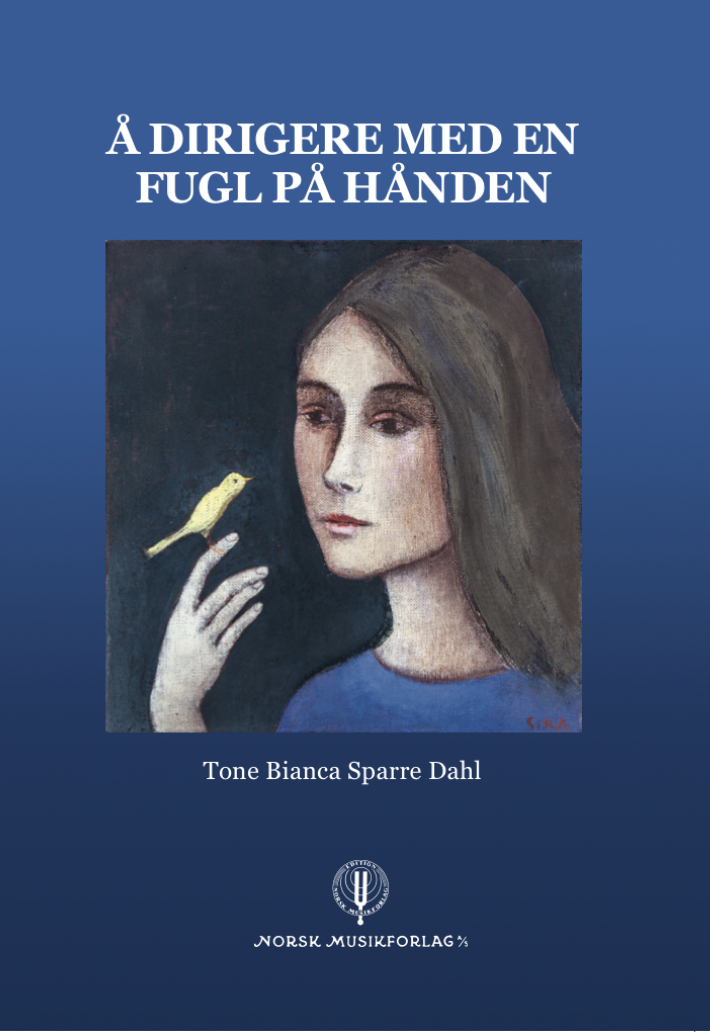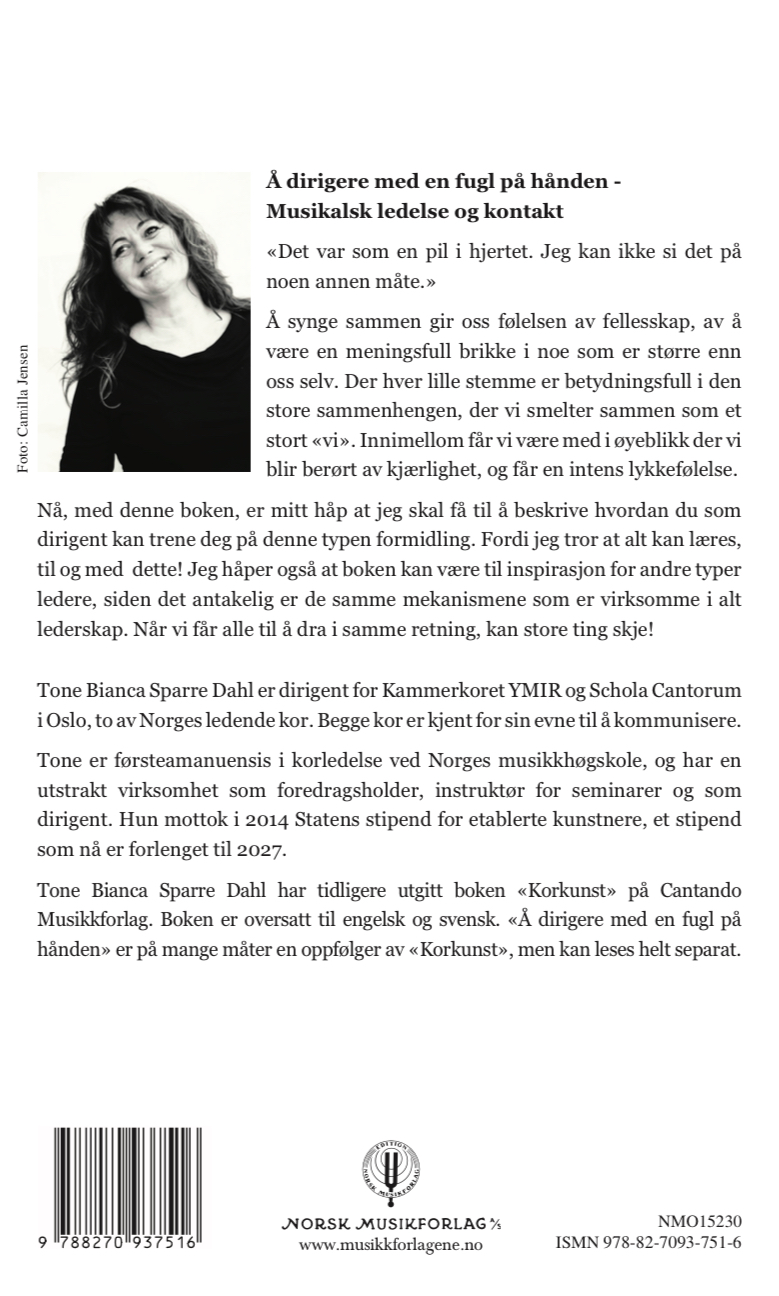My new book, «Å dirigere med en fugl på hånden. Om musikalsk ledelse og kontakt» was published in November 2023 at Norsk Musikforlag.
It will be translated to English with the title «Conducting with a bird on the hand – Musical Leadership and Interaction», and will be published in 2024.
«It was like an arrow piercing my heart. I can’t put it any other way.»
Singing together gives us the sense of community, of being a meaningful piece in something larger than ourselves. Where each small voice is significant in the grand context, where we merge into a collective «we.» Occasionally, we get to experience moments where we are touched by love and feel an intense sense of joy. Now, with this book, my hope is to describe how you, as a conductor, can train yourself in this kind of communication. Because I believe that everything can be learned, even this! I also hope that the book can serve as inspiration for other types of leaders, as the same mechanisms are likely at play in all forms of leadership. When we get everyone moving in the same direction, great things can happen!
Tone Bianca Sparre dahl: Å dirigere med en fugl på hånden – om musikalsk ledelse og kontakt.
Forhåndsbestilling av signert eksemplar

Earlier book (2002)
The book «The Choir – singing, leading, communicating» can be purchased through http://www.cantando.com. It is also available online.
The Choir –singing, leading, communicating.
Tone’s aim has been to write in simple terms about complicated issues, believing that this is one of the keys to success. The book is easy to read but deals with essential matters of voice production, leadership and communication.Tone conducts workshops for singers all over the world, mainly concentrating on communication between choir and conductor, and she is particularly interested in exploring the idea of the “magical moment” in music-making.Tone teaches singing at high school level and is an associate professor of choir conducting and stage-craft at the Norwegian State Academy of Music in Oslo. She is also conductor of the of Oslo University’s choir, Schola Cantorum, regarded as one of the best chamber choirs in Norway –noted particularly for its ability to communicate through singing.
Tone Bianca Dahl is Professor of Conducting at the Norwegian Academy of Music and conductor of Schola Cantorum, whose recording Audiens was favorably reviewed in CJ (August 2010, p. 71). Dahl’s book The Choir is a refreshing source of ideas for those already proficient in the craft of conducting and the basics of vocal technique. The volume is divided into three sections. The first, “Voice production and warming up,” includes an intelligent discussion of various aspects of voice production and registers. The warm-ups are reasonable and should be effective.
The second section, “The Conductor,” emphasizes careful preparation and perceptive listening. Penetrating questions abound. The author asks, “Why do I do what I do?” “What is my intention in presenting music I have chosen?” “Do I have something to say with the music?” Learning a piece requires translating and interpreting the text and knowing each of the parts and how they relate to each other. “Rehearsing” proffers many practical suggestions. Prepare thoroughly, begin on time, concentrate on difficult passages, correct mistakes immediately, tell the choir why you are going over something again, demonstrate, use humor, mix the voices, and end on time. Intonation receives a lengthy discussion. How does one help the choir sing in tune? Reasons for intonation problems, such as poor vocal technique and fatigue, are explored. An informative exposition of equal and just intonation in choral singing follows. Throughout the section, the author constantly admonishes conductors to hone their listening skills.
Like many passages in the book, Dahl’s discussion of “Intentions” is both practical and philosophical. Planning a rehearsal or a concert begins with intentions. The frame (design) of the rehearsal reflects the intention of the conductor. The section on “Chunking” considers a strategy for handling large amounts of information. These need to be broken down into manageable size (chunks) before the short-term memory can retain them. Dahl uses chunking as an intellectual exercise with her singers, and applies it to warming up and conducting.
“Communication” is the final section of the book. “Pacing and leading” suggests using every sensory channel in order to get through to singers. A conductor must be aware of how he/she appears to a choir, how explanations can be varied in tempo, pitch and tone to communicate more effectively. “The song inside us – being inside the song” rejects self-imposed limitations in singers. The author’s writing is poetic as she concludes “My task as a conductor is to help singers overcome such imagined limitations and lead them to experiencing the inner power and beauty of the music – perhaps those magic, golden moments during a concert, or during a rehearsal.”
Dahl’s useful and artistic ideas tumble out with fascinating passages on “Body and breathing,” “The choir as energy field,” and “Speaking to your choir.” The author’s thoughts about “Presuppositions” emphasize being responsible for how you view the world and how others perceive you. Dahl writes of three aspects necessary to successful communication: presence, balance, and flow. A successful conductor does not overreact but reacts when necessary. He/she has the courage to make unpopular decisions and stand up for them, and has the fortitude to reverse a decision. Conductors can be firm without being angry. They should radiate a sense of calm and purposefulness.
The energy of the writing and of the author’s challenging thoughts reach their climax in three stimulating topics under the umbrella “Communication between choir and conductor.” In “Non-verbal communication” the author writes “Behind everything you can see, hear or feel are my thoughts and feelings, my attitude to life, my suppositions, expectations, prejudices, decisions. . . I have to send the right signals, what I want in return.” In “Everybody is responsible for communication” Dahl writes, “The conductor must have the requisite expertise, so that the singers can place their voice in his hands without risking anything.” And in “A choir with the power to move,” Dahl describes a mountaintop relationship. “Everyone is aiming for what the conductor is aiming for right now. You can sense that the choir and conductor breathe together, one organism, one sound, a moving, living collective. You can hear and see their mutual trust and devotion to each other and the music.”
The book closes with practical advice about relationships with the choir committee, formulating goals, planning, and how to handle arriving late or when someone has to leave the choir.
Andrew Smith’s English translation is clear and easy to read. The text appears attractively on the page with Dahl’s lists of terms, concepts, etc set apart with bullets. Illustrations, many by children, add a pleasant visual element. Poems by Lise Knudsen interspersed through the book evoke lovely atmospheres that complement the text. Her subjects include connections to the past, the art and emotions of singing, and a whimsical description of the voice parts in a choir (“The tenor sets off like a champagne cork,” “The alto has a crush on C- sharp minor”). The bibliography has limited usefulness. Of the forty-five books cited, nineteen are in English, sixteen in Swedish, seven in Norwegian, two in Danish, and one in German.
The Choir is full of fresh ideas, new terms, thought-provoking discussions and abundant inspiration. Choral conductors will find much of value in this well-written book.
Conan Castle
Warrensburg, MO 64093, USA
